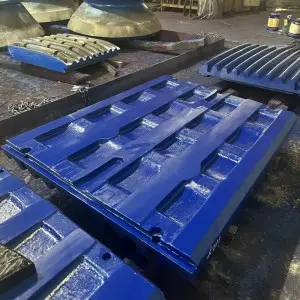During the operation of the crusher, the meshing accuracy of the fixed jaw and the swing jaw is one of the key factors affecting the particle size of the crushed particles. This precision not only determines the crushing effect of the material, but also directly affects the production efficiency and the quality of the final product. This article will delve into the influence of the meshing accuracy of fixed jaws and swing jaws on the particle size of the crushed particles, as well as how to enhance the crushing effect through optimized design and maintenance.
First, the basic concept of bite accuracy
The biting accuracy refers to the precise degree of mutual fit between the fixed jaw and the swing jaw during operation. High-precision interlocking can ensure that the material is evenly squeezed and sheared during the crushing process, thereby achieving the ideal crushing particle size. In practical applications, the biting accuracy is influenced by multiple factors, including the manufacturing accuracy of the jaws, the installation accuracy, and the wear condition.
Second, the influence of biting accuracy on the particle size of the crushed particles
(1) Uniformity of crushed particle size
High-precision interlocking can significantly improve the uniformity of the crushed particle size. When the meshing accuracy of the fixed jaw and the swing jaw is high, the force acting on the material during the crushing process is more uniform, thus making the particle size distribution after crushing more concentrated. For instance, in a jaw crusher, by precisely adjusting the gap between the jaws, materials with a feed particle size of up to 40 millimeters can be crushed to 0.5 millimeters, and the particle size distribution is uniform.
(2) Controllability of crushing particle size
The biting accuracy also directly affects the controllability of the crushed particle size. By precisely controlling the gap between the fixed jaw and the swing jaw, the particle size of the crushed particles can be precisely adjusted. In some advanced crusher designs, adjustable jaws are adopted, which can flexibly adjust the biting gap according to different material characteristics and crushing requirements, thereby achieving precise control of the crushing particle size.
(3) Crushing efficiency
High-precision interlocking not only enhances the uniformity and controllability of the crushed particle size but also significantly improves the crushing efficiency. Precise interlocking can reduce the ineffective movement of materials during the crushing process and improve the effective utilization rate of crushing force. In addition, high-precision interlocking can also reduce the residence time of materials in the crushing chamber, thereby enhancing the processing capacity of the crusher.
Third, factors affecting bite accuracy
(1) Manufacturing accuracy of the jaws
The manufacturing accuracy of the jaws is a fundamental factor affecting the biting accuracy. High-precision jaw manufacturing can ensure that the jaws maintain good contact and fit during operation. During the manufacturing process, it is necessary to strictly control the dimensional accuracy and surface roughness of the jaws to ensure their precision during installation and use.
(2) Installation accuracy
The installation accuracy of the jaws is equally important. During the installation process, it is necessary to ensure that the centerlines of the fixed jaws and the swing jaws are aligned and the gaps are uniform. Any installation deviation may lead to a decrease in biting accuracy, thereby affecting the crushing effect.
(3) Wear and tear conditions
The wear of the jaws is one of the important factors affecting the biting accuracy. As the usage time increases, the surface of the jaws will gradually wear out, resulting in an increase in the biting clearance. To maintain high-precision biting, it is necessary to regularly inspect and adjust the clearance of the jaws, and replace severely worn jaws when necessary.
Fourth, methods for optimizing bite accuracy
(1) Adopt high-precision manufacturing processes
In the manufacturing process of the jaws, the adoption of high-precision manufacturing techniques can significantly enhance the accuracy of the jaws. For instance, by adopting advanced numerical control processing technology, it can be ensured that the dimensional accuracy and surface roughness of the jaws meet the design requirements.
(2) Precise installation and commissioning
During the installation process, it is necessary to operate strictly in accordance with the technical requirements to ensure that the centerlines of the fixed jaws and the swing jaws are aligned and the gaps are uniform. After installation is completed, multiple adjustments are still required to ensure that the biting accuracy reaches the best state.
(3) Regular maintenance and inspection
Regular maintenance and inspection are the keys to maintaining high-precision occlusion. It is necessary to regularly check the wear of the jaws and adjust the biting clearance in a timely manner. In addition, it is necessary to regularly clean the debris in the crushing cavity to prevent it from affecting the biting accuracy.
Fifth, Conclusion
The meshing accuracy of the fixed jaw and the swing jaw has a significant impact on the particle size of the crushed particles. High-precision interlocking can significantly enhance the uniformity and controllability of the crushed particle size, and at the same time improve the crushing efficiency. By optimizing the manufacturing process of the jaws, precise installation and commissioning, as well as regular maintenance and inspection, the biting accuracy can be effectively improved, thereby achieving the ideal crushing effect. In the design and operation of the crusher, full attention should be paid to the control of the biting accuracy to improve the performance and production efficiency of the crusher.
Post time: Oct-27-2025

